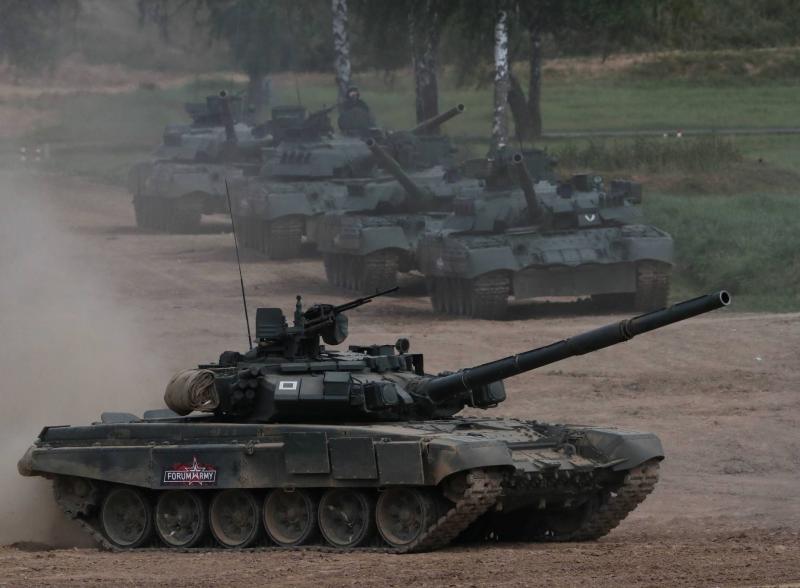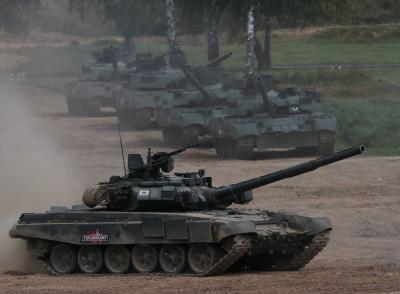Under the title "Sufficient for an Incursion: Satellites Reveal Massive Russian Troop Buildup at Ukraine Border," the Alhurra website reported on the Russian military build-up along the Ukrainian border. It highlighted that satellite images have revealed the extent of the Russian military presence, showing Russia moving warplanes to Crimea and bases near Ukraine more significantly than previously disclosed, thus increasing its capability for political intimidation or military intervention.
The images, reviewed by The Wall Street Journal, displayed a number of Su-30 fighters lined up on a runway at an airbase in Crimea. The newspaper confirmed that these aircraft were not present in late March. The photos suggest that Russian military units in Crimea include airborne troops, armored units, attack helicopters, smoke generators, drones, jamming equipment, a military hospital, as well as Su-34, Su-30, Su-27, Su-25, and Su-24 aircraft. The satellite images were taken between March 27 and April 16 by Maxar Technologies, a commercial satellite imaging company that provides extensive imagery for the U.S. and other Western governments.
Philippe Breedlove, a retired U.S. Air Force general who served as a NATO military commander when Russian forces were mobilized, stated, “They have appropriately deployed various elements of air power that will be necessary to achieve air superiority over the battlefield and directly support ground forces.” Breedlove noted that the images suggest the Russian units are not immediately prepared to attack but acknowledged that Moscow has multiple options for military action.
William Burns, the director of the U.S. Central Intelligence Agency, provided a similar assessment to Congress last week, confirming that Russian deployments could aim to intimidate the Ukrainian government and send a message to the Biden administration. Burns told the Senate Intelligence Committee, “This build-up has reached the point where it could provide the basis for a limited military incursion. So this is something that needs to be taken seriously not just by the U.S. but also by its allies.”
For its part, the Biden administration has prepared several options for lethal and non-lethal military assistance to Ukraine in case of a Russian attack, including options for anti-tank, ship, and aircraft systems, according to a person familiar with the deliberations.
Russian Defense Minister Sergei Shoigu stated last week that his country is conducting exercises in response to NATO movements that “threaten Russia” and accused Ukrainian authorities of trying to escalate tensions. U.S. officials estimate that there are currently up to 80,000 Russian troops in Crimea and near Ukraine, while Josep Borrell, the European Union’s foreign policy chief, estimated the number at over 100,000.
According to a U.S. military official, the Russian force currently consists of 48 tactical battalion groups, each comprised of several hundred soldiers and officers. However, the official noted that U.S. intelligence has yet to detect all logistical capabilities and supporting units that could be generally used for a large-scale attack across the border into Ukraine, including ammunition stockpiles and deployable hospitals.
Experts suggest that Russian President Vladimir Putin may be trying to pressure Ukraine to resume water supplies to Crimea, which were cut off by Kyiv authorities after the Kremlin annexed the peninsula. Ukrainian President Volodymyr Zelensky called on his Russian counterpart Vladimir Putin to meet him in the conflict area with Russian-backed separatists in eastern Ukraine, emphasizing that “the lives of millions of people” would be at risk in the event of a Russian-Ukrainian conflict.
Zelensky stated in an address to the nation, “Mr. Putin! I am ready (…) to meet you anywhere in Ukrainian Donbas where the war is ongoing.” He added, “The Russian president once said: If a battle must occur, the attack should be initiated. But in my opinion, every leader must realize that a battle can be avoided when it concerns (…) an actual war with millions of lives at stake. It is not too late” to prevent human loss.
He clarified, “Does Ukraine want war? No. Is it ready for it? Yes (…) We are not afraid because we have a wonderful army and defenders. We do not destroy other regions or other peoples. But that does not mean we will allow ourselves to be destroyed.”
After a broadly respected ceasefire during the second half of 2020, confrontations have increased since the beginning of this year between Kyiv forces and Russian-backed separatists, which Moscow is considered to be militarily and financially supporting. Meanwhile, tension has escalated with Moscow deploying tens of thousands of soldiers near the Ukrainian border in recent weeks, raising fears in Kyiv of a large-scale military operation.
Ukraine accuses Russia of seeking a pretext to invade, while Moscow asserts that it “does not threaten anyone,” while denouncing supposed “Ukrainian provocations.” The war in eastern Ukraine has resulted in over 13,000 deaths since it began in 2014 following Moscow's annexation of Crimea.




